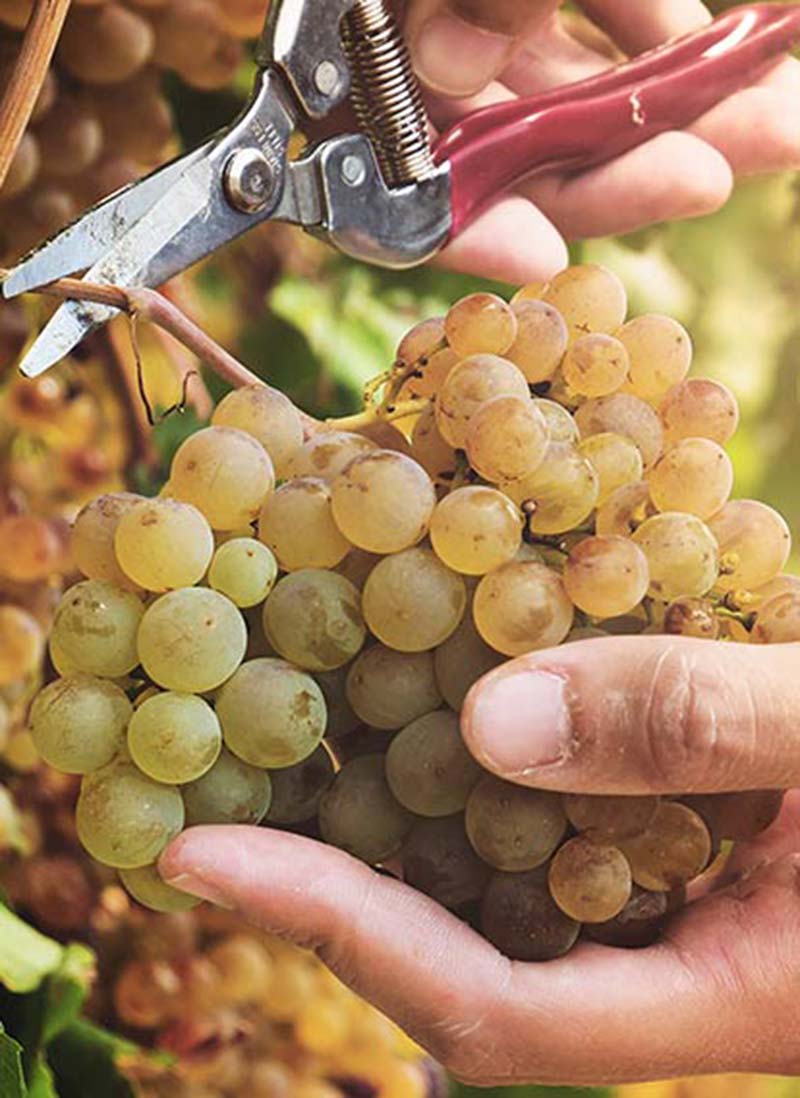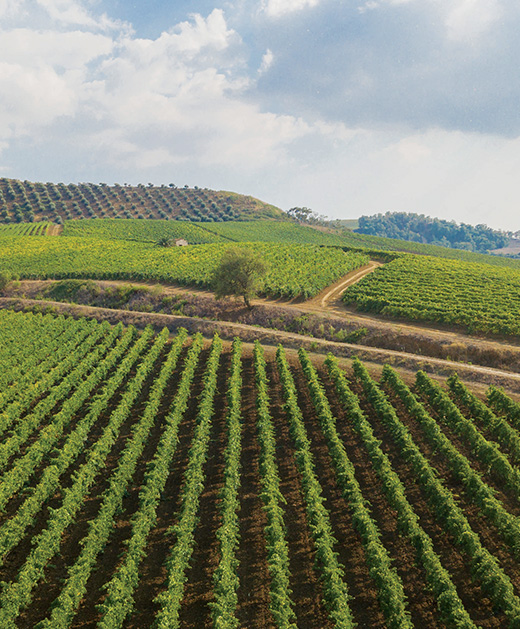Vine growing, vinification, trade. The earliest evidence of viticultural activity in the Monreale area dates back to the Middle Ages, a long history culminating in the recognition of the DOC on November 2, 2000.
The DOC grapes are produced in an area that includes a large part of the territory of Monreale and several neighbouring municipalities: a vast region once ruled by the powerful Archbishopric. Its origin is inextricably linked to the Abbey of Santa Maria La Nuova (founded at the time of the Norman conquest) – and, consequently, to the rule of William II of Hauteville. The land, after the abolition of feudal privileges of 1812 was acquired by the Municipality of Monreale. The year 1182 was a turning point: a solemn act, drawn up in the three official languages of the Norman kingdom (Greek, Latin and Arabic), established the boundaries of the granted area and listed all the districts where vines were grown. A tangible testimony of the important role played by viticulture at the time: vine growing, vinification and the wine trade, anything related to the export and consumption of wine was in fact thoroughly regulated.

The DOC grapes are produced in an area that includes a large part of the territory of Monreale and several neighbouring municipalities: a vast region once ruled by the powerful Archbishopric. Its origin is inextricably linked to the Abbey of Santa Maria La Nuova (founded at the time of the Norman conquest) – and, consequently, to the rule of William II of Hauteville. The land, after the abolition of feudal privileges of 1812 was acquired by the Municipality of Monreale. The year 1182 was a turning point: a solemn act, drawn up in the three official languages of the Norman kingdom (Greek, Latin and Arabic), established the boundaries of the granted area and listed all the districts where vines were grown. A tangible testimony of the important role played by viticulture at the time: vine growing, vinification and the wine trade, anything related to the export and consumption of wine was in fact thoroughly regulated.


Wine being a taxed good, locals were expected to declare any quantities produced or owned. As for those who made a living transporting wine, a special tax had to be paid one hour before delivery. The documentation shows how the price of wine was set every year and how the average consumption was also carefully recorded, both for adults (people over 12 years of age) – who consumed almost one and a half litres a day – and children under 12, estimated to almost half litre.
Viticulture in the Monreale Doc area has ancient roots and throughout the eighteenth century the archbishopric of Monreale owned 60,000 hectares of land, most of it administered directly by the bishop. A thriving viticultural tradition and a profitable activity which, in the course of the 1990s, has evolved towards the achievement of greater quality, spurred on by the rebirth of Sicilian winemaking of the previous decades: new wineries and new vineyards, managed with increasing skill by a new wave of professionals working on every facet of winemaking. A revolution which has brought domestic and international recognition to Sicily’s top Doc productions.
Wine being a taxed good, locals were expected to declare any quantities produced or owned. As for those who made a living transporting wine, a special tax had to be paid one hour before delivery. The documentation shows how the price of wine was set every year and how the average consumption was also carefully recorded, both for adults (people over 12 years of age) – who consumed almost one and a half litres a day – and children under 12, estimated to almost half litre.
Viticulture in the Monreale Doc area has ancient roots and throughout the eighteenth century the archbishopric of Monreale owned 60,000 hectares of land, most of it administered directly by the bishop. A thriving viticultural tradition and a profitable activity which, in the course of the 1990s, has evolved towards the achievement of greater quality, spurred on by the rebirth of Sicilian winemaking of the previous decades: new wineries and new vineyards, managed with increasing skill by a new wave of professionals working on every facet of winemaking. A revolution which has brought domestic and international recognition to Sicily’s top Doc productions.

The Monreale DOC extends over the north-western hills of Sicily, at altitudes ranging from 300 to 600 meters above sea level: perfect conditions for the practice of top-quality viticulture.

The geographical area dedicated to the production of DOC Monreale wine spans across the hills of north-western Sicily, an area that offers good ventilation, plenty of sunlight and the perfect climate to promote the growth of fragrant, healthy grapes. Winters are mild, followed by five months of hot and dry weather (May-September), while rainfall mostly occurs between the months of October and December. Vineyards are planted at an average altitude ranging between 300 to 600 meters above sea level in well-drained clayey-sandy soils with a good presence of organic compounds and a balanced acidity.
The production of the DOC (one of Sicily’s main denominations) occupies an area of the province of Palermo that includes the municipalities of Monreale, Piana degli Albanesi, Camporeale, San Giuseppe Jato, San Cipirello, Santa Cristina Gela, Corleone and Roccamena. A vast region that forms a large part of what was once the powerful Archbishopric of Monreale which, over time, saw the rise the Sicilian Fasci and became the testing ground of very important agrarian reform. The region is now home to eight wine estates, a rich landscape of diverse vineyards and soils, divided into three macro areas: Corleonese, Camporeale area and Valle dello Jato.
Corleonese
A vast area that includes the municipalities of Corleone, San Giuseppe Jato and San Cipirello. The soil here is brown and chalky, tends to become clayey at higher altitudes, sandy and medium-textured close to the banks of the Jato river. The climate is typically Mediterranean with cold and rainy winters while the summer season is hot and dry. Diurnal temperature variations, average rainfall and solar irradiation all combine to offer excellent conditions for the vegetative development of the grapes.
Camporeale
The Camporeale area has become quite the wine-growing sensation in recent years, owing to the success of its recently introduced Syrah. The soils are fertile, medium-textured with a moderate presence of gravel and clay. At higher altitudes we find strong winds and abundant rainfall throughout the year, a particularly favourable microclimate for viticulture.
Valle dello Jato
A medium-hill area located at altitudes ranging between 250 and 350 m above sea level – the soils are alluvial and rich in clay. Heading towards the upper part of the Jato river we reach Monreale, where the altitude rises to 700 meters. The presence of mountain elevations such as Rocca Busambra ensures strong winds and abundant rainfall. Soils are dark, granular and moist with an optimal quota of organic compounds.
Municipalities
Monreale, Piana degli Albanesi, Camporeale, San Giuseppe Jato, San Cipirello, Santa Cristina Gela, Corleone e Roccamena.
Main sites of cultural interest
Corleone
- Borgo Schirò
- Bosco della Ficuzza
- Gorgo del Drago (Godrano/Corleone)
- Real Casina di Caccia
- Rocca Busambra
Monreale
- Abbazia dei Benedettini
- Castellaccio di Monreale
- Chiostro di Monreale
- Duomo di Monreale
Piana degli Albanesi
- Bosco dell’Eparchia
- Chiesa di S. Giorgio
- Lago di Piana degli Albanesi
San Giuseppe Jato/San Cipirello
- Monte Jato
- Area Archeologica di Monte Iato






